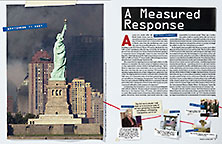 In the wake of 9/11, New York City built an unprecedented counterterrorism force of its own: 1,000 committed officers, an Intelligence Bureau, and 10 officers dispatched as full-time liaisons to police departments in the Middle East, Europe, and Southeast Asia. The elaborate program turned the joke about the mayor of New York City having a foreign policy into a “literal truth,” observes Assistant Professor of Law Samuel Rascoff, who ran the city’s counter terrorism intelligence desk for two years before joining NYU Law in 2008.
In the wake of 9/11, New York City built an unprecedented counterterrorism force of its own: 1,000 committed officers, an Intelligence Bureau, and 10 officers dispatched as full-time liaisons to police departments in the Middle East, Europe, and Southeast Asia. The elaborate program turned the joke about the mayor of New York City having a foreign policy into a “literal truth,” observes Assistant Professor of Law Samuel Rascoff, who ran the city’s counter terrorism intelligence desk for two years before joining NYU Law in 2008.
As a scholar, Rascoff has been considering “the paradox of national security federalism.” We tend to think of terrorism as a national and global challenge, one necessarily countered by agencies and officials in Washington. New York’s unique response to 9/11, however, argues for local control over key counterterrorism functions. As Rascoff has observed, “Local departments…‘see’ the threat more clearly than their national counterparts: officers…know their [mainly urban] terrain, speak relevant languages, and are able to leverage their status as…peacekeepers within the community to useful effect.”
Embracing this position leads Rascoff to reject the debate over whether counterterrorism is a function of the criminal justice system or a form of warfare. “Crime, unlike terrorism, happens every day and does not threaten the political order,” he explains. But neither is counterterrorism warfare. “Wars end, but counterterrorism will require a sustained effort over at least a generation.” Instead Rascoff posits counterterrorism as a form of risk regulation, something akin to controlling pollution or ensuring drug safety. To preempt mass violence, government must begin by getting better at intelligence gathering and analysis, he says, using a wide range of “risk assessment” tools. It will then be in a position to engage in various “regulatory interventions,” from softer approaches (as when officials reach out in a conciliatory way to local Muslim leaders) to more hard-edged techniques, as in the case of the NYPD’s periodic deployment of scores of vehicles, lights flashing and sirens blaring, to send a message that potential targets will be difficult to attack.
Counterterrorism as risk regulation also suggests a need for rigorous balancing of relative dangers in deciding whether limited resources ought to be directed to all 50 states or concentrated in those cities and around infrastructure like nuclear plants that present the most pronounced risks. Finally, all branches of government must play more of an oversight role in making sure that terrorism regulation obeys the rule of law. “We need a model of counterterrorism law that is sustainable, that treats the threat in the way of a chronic health issue,” he concluded, “not an acute problem that can be cured with a rapid surgical intervention.”
—
